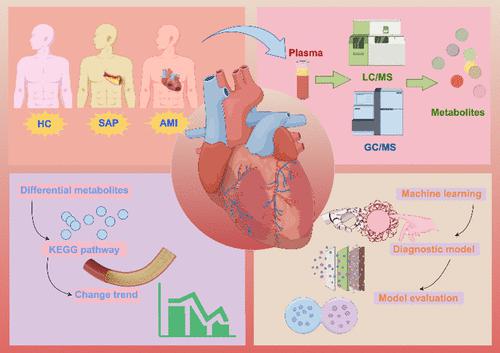Our official English website, www.x-mol.net, welcomes your feedback! (Note: you will need to create a separate account there.)
Plasma Metabolic Profiling and Multiclass Diagnostic Model Development for Stable Angina Pectoris and Acute Myocardial Infarction
ACS Omega ( IF 4.1 ) Pub Date : 2024-03-26 , DOI: 10.1021/acsomega.3c10474 Ruixia Lu 1, 2 , Wenyong Lin 1, 2 , Qipeng Jin 1, 2 , Dongyuan Wang 1, 2 , Chunling Zhang 1, 2 , Huiying Wang 1, 2 , Tiejun Chen 1, 2 , Junjie Gao 1, 2 , Xiaolong Wang 1, 2
ACS Omega ( IF 4.1 ) Pub Date : 2024-03-26 , DOI: 10.1021/acsomega.3c10474 Ruixia Lu 1, 2 , Wenyong Lin 1, 2 , Qipeng Jin 1, 2 , Dongyuan Wang 1, 2 , Chunling Zhang 1, 2 , Huiying Wang 1, 2 , Tiejun Chen 1, 2 , Junjie Gao 1, 2 , Xiaolong Wang 1, 2
Affiliation

|
Coronary heart disease remains a major global health challenge, with a clear need for enhanced early risk assessment. This study aimed to elucidate metabolic signatures across various stages of coronary heart disease and develop an effective multiclass diagnostic model. Using metabolomic approaches, gas chromatography–mass and liquid chromatography–tandem mass spectrometry were used to analyze plasma samples from healthy controls, patients with stable angina pectoris, and those with acute myocardial infarction. Pathway enrichment analysis was conducted on metabolites exhibiting significant differences. The key metabolites were identified using Random Forest and Recursive Feature Elimination strategies to construct a multiclass diagnostic model. The performance of the model was validated through 10-fold cross-validation and evaluated using confusion matrices, receiver operating characteristic curves, and calibration curves. Metabolomics was used to identify 1491 metabolites, with 216, 567, and 295 distinctly present among the healthy controls, patients with stable angina pectoris, and those with acute myocardial infarction, respectively. This implicated pathways such as the glucagon signaling pathway, d-amino acid metabolism, pyruvate metabolism, and amoebiasis across various stages of coronary heart disease. After selection, testosterone isobutyrate, N-acetyl-tryptophan, d-fructose, l-glutamic acid, erythritol, and gluconic acid were identified as core metabolites in the multiclass diagnostic model. Evaluating the diagnostic model demonstrated its high discriminative ability and accuracy. This study revealed metabolic pathway perturbations at different stages of coronary heart disease, and a precise multiclass diagnostic model was established based on these findings. This study provides new insights and tools for the early diagnosis and treatment of coronary heart disease.
中文翻译:

稳定型心绞痛和急性心肌梗死的血浆代谢分析和多类诊断模型开发
冠心病仍然是一个重大的全球健康挑战,显然需要加强早期风险评估。本研究旨在阐明冠心病各个阶段的代谢特征,并开发有效的多类诊断模型。采用代谢组学方法,使用气相色谱-质谱和液相色谱-串联质谱分析来自健康对照、稳定型心绞痛患者和急性心肌梗死患者的血浆样本。对表现出显着差异的代谢物进行途径富集分析。使用随机森林和递归特征消除策略来鉴定关键代谢物,以构建多类诊断模型。该模型的性能通过 10 倍交叉验证进行验证,并使用混淆矩阵、受试者工作特征曲线和校准曲线进行评估。使用代谢组学鉴定了 1491 种代谢物,其中健康对照、稳定型心绞痛患者和急性心肌梗死患者中分别有 216、567 和 295 种明显存在。这涉及冠心病各个阶段的胰高血糖素信号传导途径、d-氨基酸代谢、丙酮酸代谢和阿米巴病等途径。经过选择,异丁酸睾酮、N-乙酰色氨酸、d-果糖、L-谷氨酸、赤藓糖醇和葡萄糖酸被确定为多类诊断模型中的核心代谢物。评估诊断模型证明了其高判别能力和准确性。该研究揭示了冠心病不同阶段的代谢途径扰动,并根据这些发现建立了精确的多类诊断模型。该研究为冠心病的早期诊断和治疗提供了新的见解和工具。
更新日期:2024-03-26
中文翻译:

稳定型心绞痛和急性心肌梗死的血浆代谢分析和多类诊断模型开发
冠心病仍然是一个重大的全球健康挑战,显然需要加强早期风险评估。本研究旨在阐明冠心病各个阶段的代谢特征,并开发有效的多类诊断模型。采用代谢组学方法,使用气相色谱-质谱和液相色谱-串联质谱分析来自健康对照、稳定型心绞痛患者和急性心肌梗死患者的血浆样本。对表现出显着差异的代谢物进行途径富集分析。使用随机森林和递归特征消除策略来鉴定关键代谢物,以构建多类诊断模型。该模型的性能通过 10 倍交叉验证进行验证,并使用混淆矩阵、受试者工作特征曲线和校准曲线进行评估。使用代谢组学鉴定了 1491 种代谢物,其中健康对照、稳定型心绞痛患者和急性心肌梗死患者中分别有 216、567 和 295 种明显存在。这涉及冠心病各个阶段的胰高血糖素信号传导途径、d-氨基酸代谢、丙酮酸代谢和阿米巴病等途径。经过选择,异丁酸睾酮、N-乙酰色氨酸、d-果糖、L-谷氨酸、赤藓糖醇和葡萄糖酸被确定为多类诊断模型中的核心代谢物。评估诊断模型证明了其高判别能力和准确性。该研究揭示了冠心病不同阶段的代谢途径扰动,并根据这些发现建立了精确的多类诊断模型。该研究为冠心病的早期诊断和治疗提供了新的见解和工具。



























 京公网安备 11010802027423号
京公网安备 11010802027423号